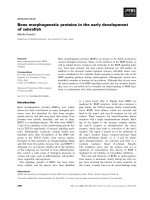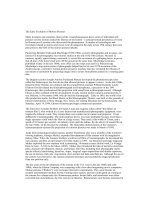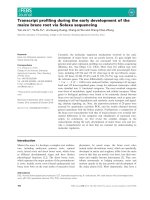Springer business idea the early stages of entrepreneurship 2005 ISBN354022663X
Bạn đang xem bản rút gọn của tài liệu. Xem và tải ngay bản đầy đủ của tài liệu tại đây (15.06 MB, 228 trang )
The Business Idea
Soren Hougaard
The Business Idea
The Early Stages
of Entrepreneurship
With 20 Figures and 17 Tables
Springer
Soren Hougaard
3 Loewaenget
2960 Rungsted Kyst
Denmark
Co-publication by Springer Heidelberg, Germany
and Samfundslitteratur, Frederiksberg, Denmark.
The original was published in 2004, ISBN 87-593-1106-1
The Danish title is: Forretningsid^en
Cataloging-in-Publication Data
Library of Congress Control Number: 2004112219
ISBN 3-540-22663-X Springer Berlin Heidelberg New York
This work is subject to copyright. All rights are reserved, whether the whole or part of
the material is concerned, specifically the rights of translation, reprinting, reuse of illustrations, recitation, broadcasting, reproduction on microfilm or in any other way, and
storage in data banks. Duplication of this publication or parts thereof is permitted only
under the provisions of the German Copyright Law of September 9, 1965, in its current
version, and permission for use must always be obtained from Springer-Verlag. Violations
are Hable for prosecution under the German Copyright Law.
Springer is a part of Springer Science+Business Media
springeronHne.com
© Springer Berlin • Heidelberg 2005
Printed in Germany
The use of general descriptive names, registered names, trademarks, etc. in this publication does not imply, even in the absence of a specific statement, that such names are
exempt from the relevant protective laws and regulations and therefore free for general
use.
Hardcover-Design: Erich Kirchner, Heidelberg
SPIN 11307839
42/3130-5 4 3 2 1 0 - Printed on acid-free paper
Contents
Preface
Introduction and summary
7
9
1. Entrepreneurship as a competency
1.1 Entrepreneurship as a concept
1.2 Who becomes an entrepreneur?
1.3 The basic competencies of the entrepreneurial process
1.4 Entrepreneurship as a process
1.5 Invention, innovation and entrepreneurship
1.6 Inventory: Entrepreneurial motives and competencies
23
24
27
28
29
31
35
2. Creative market insight
2.1 Solution versus problem orientation
2.2 The Four-Leaf-Clover Model
2.3 Occurrences in a diagnostic perspective
2.4 Incongruities as a source of ideas
2.5 Innovation as a problem detector
2.6 Missing links
2.7 Inventory: creative market insight
43
43
46
49
55
58
60
61
3. The window of opportunity
3.1 The window of opportunity, entrepreneurship and luck
3.2 A business venture typology
3.3 Domains of opportunities
3.4 The grid of opportunity as a diagnostic method
3.5 Opportunity and lifecycle
3.6 From opportunity to congregation
3.7 Window of opportunity paradoxes
3.8 Inventory: Evaluation of the window of opportunity
69
70
73
79
80
83
87
90
93
4. Creation of the business concept
4.1 How to define a business
97
97
4.2 The three main tracks of the business concept
4.3 A business definition typology
4.4 Market boundaries and entrepreneurial opportunities
4.5 Factors influencing business definition and concept design
4.6 Inventory: Creation of the business concept
- in search of uniqueness
5. Entry barriers to markets
5.1 Introduction to entry barriers
5.2 Entry barriers type A: Customer access
5.3 Entry barriers type B: Customer acceptance
5.4 Entry barriers type C: Competitor reaction
5.5 Unconventional roads to the market
5.6 Inventory: The barrier wheel
117
121
121
123
126
136
138
142
6. Strategies for market entry
6.1 Initial reflections on market entry
6.2 Entry strategy type A: First mover - first, the biggest, best
6.3 Entry strategy type B: Differentiation
6 A Entry strategy type C: Generic product-market strategy
6.5 Inventory: Entry strategies
145
146
151
157
166
169
7. The positive influence of competitors
7.1 Introduction strategy and choice of competitors
7.2 Competitors as strategic midwives
7.3 Good competitors
7.4 Comparison between useful and harmful competitors
7.5 Inventory: Competitor barometer for a new enterprise
175
175
180
189
192
194
8. Entrepreneurship and business ideas in the embryonic market
8.1 A different challenge
8.2 Approach type A: The adaptation method
8.3 Approach type B: The experimental method
8.4 Approach type C: The combination method
8.5 Strategies for a new business venture in embryonic markets
8.6 Inventory: Risk analysis and risk management
in innovative situations
199
200
204
215
217
222
224
Index
229
6
102
104
110
114
Preface
The expectation that a society in which there is a high level of innovation
and entrepreneurship will be more robust and provide better opportunities for
growth has put entrepreneurship at the top of the political agenda of the western world.
The established business community is, in fact, the primary source of new
venture activities, which is why the presence in the economy of innovative and
expansive businesses is advantageous for entrepreneurship rather than the opposite. However, if intra- and entrepreneurship is to provide momentum, this
engine — like all other engines — needs fuel and conditions contributing to opportunities and competencies.
The work behind the present book is based both on theory and practice,
more specifically on my personal experience from an everyday life full of start-up
projects, product development, strategic marketing dilemmas, business plans,
risk assessment and decisions taken under uncertainty. These are often tough
nuts to crack in a situation where the likelihood of being wrong is ever present
and where failure is costly.
During my many years as an entrepreneur and innovator, I have become
acquainted with lots of ideas, strategies and plans. It has always been a puzzle to
me why there is so much focus on business plans, but so little on business ideas. A
good friend was asked recently whether he would be interested in investing in
a start-up project. His conclusion afterwards was the following: "These young
people have prepared an amazing business plan; the trouble is that there is no
business idea behind it!" Exactly this state of affairs is characteristic of a lot of
entrepreneurial undertakings.
One reason for this apparent lack of attention and focus on the business idea
is probably an annoying deficit of methodology and techniques What do you
do to develop a competitive business idea, and how can you tell whether it is
sustainable?
From the wide range of factors that determine whether a business idea will
be successful or not, I have chosen to concentrate on a single dimension, i.e.
the market, in the sense of customers and competitors. Not because there is
anything surprising about the fact that market forces play a crucial role in de-
7
termining whether or not a business idea will be successful, but rather because
the cross-field between entrepreneurship and market is in desperate need of
major methodological enhancement.
As my academic work is strategic marketing, and as all successful strategic
marketing efforts will always contain elements of excellent entrepreneurship,
it seemed natural to seek to combine the conceptual framework of marketing
economics and the start-up situation, symbolised by the question: How can
models, lines of thought and methods that are all well-known in marketing be
translated into concrete, serviceable techniques for entrepreneurship?
The result of my work is the present book. The Business Idea — the early stages
of entrepreneurship.
I owe a debt of gratitude to a number of people for their contribution to
the process. This goes for my academic sparring partners, who have read and
commented on my manuscript - some of them several times. My colleagues
Associate Professors Henrik Johansen Duus and Kenneth Husted, both at
Copenhagen Business School, have applied their very professional skills to the
systematics, conceptual framework and use of literature in the book. My business friend Lars Ole Kornum, Managing Director, has read the manuscript
closely and been very helpful in improving the instructive value of the text while
confronting me with a number of relevant, practical questions. My son, Lars
Hougaard, MSc Econ, MIF, has, in his usual mature and analytical manner,
pointed to a considerable number of areas in which there was room for improvement in the project - almost all of which have been incorporated in the final
manuscript.
Lena Fluger has been an exemplary editorial and language anchor, and to
her, too, I am indebted.
This book contains many examples from real-life projects, some of which
have been tremendous successes while others have had to be given up. I have
tried to report these cases loyally and without compromising anybody involved;
I know from experience that the risk of failure and loss is an inseparable part of
being an entrepreneur.
In the years to come, I plan to gather additional material on the early stages
of entrepreneurship in order to be able to contribute further knowledge and
systematics that may be used in those crucial moments when the foundations
for future business are laid.
Rungsted Kyst, Denmark
July 2004
S0ren Hougaard
8
Introduction and summary
"Knowledge is proud he has learned so much;
wisdom is humble he knows no more."
William Cooper
Vision
The vision of The Business Idea is to present and explain the entrepreneurial
process from the moment an idea is conceived until the new business or business
unit is introduced on the market. The Business Idea is a framework intended to
sharpen your senses towards entrepreneurship and perhaps make you want to
have a go at it yourself The book aims at being both educational and a source
of inspiration. The focus of The Business Idea is the concrete business venture
- not the societal perspective.
In order to follow the book's vision with sufficient energy and directness, I
have chosen one specific approach to the issue of entrepreneurship, which implies
that other aspects, perhaps just as intriguing, have been left out. The approach
I have chosen may be defined as follows:
Firstly, the book deals with the early stages of establishing an enterprise or
business activity - the initial meeting between business idea and market: opportunity, concept, barriers and entry. In the book, I call this the showdown.
Excellent entrepreneurship does not stop at the first, immediate market acceptance: that is where it all begins. The market decides whether the business
venture can continue or perishes - whether it survived the showdown. This is
why this phase is all-important.
Secondly, the starting point of The Business Idea is uncompromisingly market-orientated. It is often much harder to discover a problem and understand
what makes it a problem - and thus the germ of an opportunity - than it is to
develop solutions. This point of view should not be seen as if I am underestimating the importance of technological breakthroughs or the ability to create
excellent products. It is a fact, however, that many business ventures stumble
in their misguided search for a position of strength that relies on an uncritical
belief in technology, product superiority and physical attributes, while their
customers struggle with problems and needs that are completely unrelated to
technological advances or paradigm shifts, which makes them reluctant to
embrace new inventions - and this in turn often leads to painful experiences
for the entrepreneur.
And thirdly, the book presents provokingly general thoughts on the edges
and potential of entrepreneurial ventures that are somewhat contrary to received
wisdom. For example, The Business Idea claims that fierce competition is better
than no competition, and that first mover advantages are often exaggerated or
imaginary.
The book is based on market conditions, and its frame of reference consists
of principles, methods and processes that may be used to combine special competencies with market insight to create a business opportunity. At no point does
this narrow optic underestimate the factors of surprise or talent.
Composition
The Business Idea makes use of various kinds of sources interwoven in a close
pattern which should, hopefully, come across as a well-balanced, logical entity.
Its purpose is not to deduce and generalise on an abstract basis only; nor is it
the intention to draw conclusions from one single case and generalise for all
other cases. This book has been composed by lending, condensing, relating,
combining, translating and exemplifying existing material. Its original contribution lies in its flow and focus - its composition - rather than in independent
contributions to the existing knowledge about entrepreneurship.^
Four threads are interwoven:
•
Theories on entrepreneurship, market-related strategy and competitive advantage at business level. In this respect you will be hard pushed to find
The Business Idea contains an interaction between life inside the individual business
venture and a cool distance to it. Thus, conclusions and generalisations have been
created in a combined interaction between people and projects going through the entrepreneurial phase, and an interpretation of such situations. This process must necessarily be characterised by alternating enthusiasm, empathy and antipathy in order to
be interpreted and put into perspective.
10
better ideas than those of classics such as Abell, Drucker, Porter, Prahalad &
Hamel, Day, Levitt, D'Aveni, if you are interested in the individual business
venture.
• Typologies and models that are partly deduced from formal theories and
partly consist of necessary, practical concepts. The models deal with central
topics related to market-orientated entrepreneurship and may be used as
guidelines in specific situations. In this way they become integral elements
of the frame of reference.
• Examples and cases support and illustrate formal theories and increase the
legitimacy of the outline. In addition, the examples may function as independent inspirational cases and as points of confrontation for the individual
who is working on an entrepreneurial problem in practice or in the course
of a study programme.
• Personal experience and events. It is debatable whether this aspect has any
predictive value. On the other hand the qualitative generalisation - the case
method - may be said to be quite reliable, if sources are sufficiently varied
and the observer sufficiently unbiased. Whatever the case may be, many
years of intimate association with entrepreneurship have shown that people
of experience - good and less good - have a lot of relevant messages to send.
Entrepreneurship bears many similarities to craftsmanship.
The vision is to formulate, illustrate and communicate information on the progression of the various stages of entrepreneurship and in so doing to present a
conceptual framework for the meeting between the new business idea and the
market. This is done through an interchange between theory and practice and
between presentation, discussion and generalisation.
Progression
The choreography of The Business Idea is the driving force of markets opposite
the ingenuity of the entrepreneur. The progression of the book - its ongoing
logic - reflects the development that begins with the entrepreneur's very special
motives, ideas and competencies and ends with the hopefully successful introduction of the new business venture on the market. The progression that the
reader may expect is the unfolding of the entrepreneurial process into a sort of
simulation or mental trip that goes from the individual's deliberation over goals
and motives to the introduction of the young business on the market:
11
Fig. 0.1: The Business Idea - progression
The sequential design of business ventures into a few - limited - stages is the
guiding principle of The Business Idea. The book offers a sequential model for
entrepreneurship in a market perspective as shown in the figure, but does not
provide a list of correct answers. Do not expect a manual of quick recipes for
instant sales success. The book is full of theories, of unsuccessful business ventures and of doubt. But its undertone is basically positive: Get cracking— a lot
more people could become capable entrepreneurs.
Scope of application
The purpose of The Business Idea is both narrow and broad. The narrow purpose
lies in its foundations and approach expressed in the question:
12
How is it possible to create business opportunities by creatively understanding a market and by combining this understanding with the
competencies encompassed by the individual business venture?
This approach to innovation and entrepreneurship is a major element in marketing as a discipline, and it narrows down the natural applications of this
book in relation to the aggregate relevant subject and functional areas that are,
in practice, also vital elements of successful entrepreneurship; this includes
financing, project management, preparation of business plans, technology assessment, organisational development, general management, decision theory
in risk situations etc.
The subject of the book is the market and the extent to which viable - often
unexpected - business ideas may be born from empathy, insight, creativity and
knowledge. The scope of the book is thus restricted to systematics and methods
for developing innovative business ideas - which should not be confused with
fantastic products.
The broader objective of the book is that the philosophy and models for business creation that is provided should make a positive contribution in many different contexts. Any person who works with, wants to know more about, or is
studying the subjects of innovation and entrepreneurship may find The Business
Idea useful. The book is suitable for teaching purposes as well as for practical use
in start-up situations or in connection with consultancy and development guidance. The Business Idea may be used at a very concrete level for methodological
support, skills enhancement or as a source of inspiration and motivation.
Summary
Chapter 1, Entrepreneurship as a competency^ lays the foundations. This chapter
defines the concept of entrepreneurship and helps the reader evaluate his or
her own competency profile in an imaginary entrepreneurial role. Business ventures are propelled by people's sense of opportunity. Opportunities result from
creation, the ability to see and understand problems and develop unexpected
solutions. The conclusion is that entrepreneurship is not a privilege belonging
to a small, select group of special personalities, but that it can be regarded as a
social construction arising anywhere and involving anybody.
Entrepreneurship is teamwork, and Chapter 1 presents the basic competencies of entrepreneurship: the analytical-diagnostic force, the creative-in13
novative force and the interactive-communicative force. Successful ventures
encompass and unite these Graces, preventing an imbalance from occurring.
The chapter also outlines the concepts of invention - technical perfection
without any immediate commercial value - as opposed to innovation, which
is the development of new methods, processes and products - i.e. applications
widely compared to entrepreneurship, at the core of which are the opportunity
and the chance to do something differently, better or at lower cost.
The basic thesis of The Business Idea is that it is possible to learn entrepreneurship, and that sustainable ideas require equal, dynamic interaction between very
disparate competencies and thus between people.
Chapter 2 (ocuscs on creative market insight. The innovative quality of strong
business ideas is the unexpected solution. The unexpected solution is often
founded on creative market insight - which should not be confused with
conventional market insight. To uncover the unknown, to be able to look at
the market and at needs from new angles requires profound knowledge and
special skills. The chapter evolves around the Four-Leaf-Clover Model, i.e. four
main roads leading to unique understanding of problems and opportunities.
These are:
a) Occurrences i.e. events and changes - both unrecognised and well-known
- that open the door to new business ventures created through the entrepreneur s interpretation and combination of information to develop opportunities;
b) Incongruities — latent weaknesses - that are just waiting to be discovered
and remedied;
c) Innovation that creates needs and makes opportunities stand out. Innovation
very often consists of technological achievements combined with new processes, materials or forms of organisation that add up to conditions for opportunity;
d) Missing links: obvious shortcomings, weak links, etc. that everyone has
become used to, but which may be eliminated if you can catch sight of the
blockages.
Even though Chapter 2 suggests that finding openings is about systematics and
detailed knowledge, the element of surprise will always determine whether an
opening holds potential financial value.
14
One possibility is, of course, the opportunity of meeting a market need by
means of a creative combination of resources, which will lead to exceptional
value. Chapter 3 focuses on this window of opportunity. The perceptual window
implies that the opportunity impulse is creative insight into the market, as distinct from the conceptual window; here the window of opportunity is created
by the entrepreneur's special competencies. This distinction leads to four types
of strategic windows: Problem solving, business formation, technology transfer
and dream.
Chapter 3 also presents and describes the grid of opportunity - a method
that allows the new venture to test its business idea in relation to the combination of customer lifecycle and field of value; in short, how and why an idea or
a concept may create exceptional value. The grid of opportunity is the acid test
for customer understanding and identification of needs.
The chapter then moves on to present the link between opportunity and
congregation: many entrepreneurs have a preconceived idea that product superiority is a necessary and sufficient condition for success. As a consequence
they risk underestimating the importance of reaching the very target group for
whom innovation makes all the difference - as, for example, in the case of Nike
and long-distance runners.
The chapter ends with a couple of tricky paradoxes, dogma killers, concerning
the window of opportunity. Their special purpose is to make the entrepreneur
take a critical stance on some of the factors that are usually regarded as the aces
of a business venture. These factors include: the technical level of innovation,
absence of competition, the number of interesting customer segments, the fact
that major changes lead to great opportunities and that trusted friends are the
most important source of inspiration.
From finding market openings and identifying the window of opportunity.
Chapter 4 takes a further step into the entrepreneurial process, i.e. to the creation of the business concept, symbolised by the question of how to define the
business.
Reaching a sustainable business definition is a separate and challenging
process. The business definition will often be the innovation itself The business
concept is created through the processing of and decision on three basic dimensions or axes, namely: customer groups (who), functions (by what means) and
technologies (how). Business concepts may be divided into three main groups
based on their level of focus and differentiation:
15
Figure 0.2 Business concepts
A focused business concept concentrates on one and only one of the three basic
dimensions mentioned above, e.g. one particular customer group. A differentiated business concept seeks broad market appeal, differentiating by one or more of
the dimensions in relation to customers or different needs. The undifferentiated
business concept entails that the new enterprise defines its business broadly in
relation to all three basic dimensions while, at the same time, refraining from
differentiating the way in which the enterprise is organised vis-a-vis competitors
or across customer segments.
There are many different factors that need to be incorporated when the new
venture is defining its business concept, as a minimum the following: (1) buyer
behaviour - differences in need and price sensitivity, (2) resource and competency
requirements and (3) cost ratios - how pronounced and inevitable are the economies
of experience and scale, and finally (4) the chance of redefining the market.
One good example of this is DDH, a Danish organisation that was founded
in 1866 with the purpose of making the moors of Jutland arable. The organisation still exists even though its mission has long since been fulfilled. Why? The
D D H did not define its business as agriculture but as landscape protection.
Visionary and sustainable business concepts have to relate to market entry barriers, which are the topic of Chapter 5. Entry barriers are obstacles and opponents
16
that affect the chances of new businesses and products of gaining a foothold
in the market - the very first prerequisite for success. Chapter 5 operates with
three categories of entry barriers:
Fig. 0.3 Main categories of entry barriers
Only a fool does not fear obstacles to market entry. Customer access - distribution
- is, in many cases, the most critical success factor, and requires special attention; distribution and positioning in the overall value chain must be incorporated into the business concept as well as into the business model chosen. This
is evident within the IT/software sector where talented entrepreneurial projects
tend to suffer an early death due to e.g. lack of customer access, caused by the
fact that, from day one, unimpeded, efficient, transnational distribution is one
of the business sector's most critical success factors. Capital requirements, fear
of cannibalisation and retaliation from established suppliers are other factors
that may reduce a new company's access to customers.
Customer acceptance presupposes that the new venture is able to match the
cost and quality protection of established suppliers, symbolised by the perceived
relative price and quality. Factors such as economies of scale, experience, systems
ties, transaction costs, product differentiation, compatibility, references and
brand value may individually or in combination amount to terrifying entry
barriers for an upstart with few resources.
17
Competitor reaction is often - for very good reasons - deadly. The chapter
contains an indicator system for expected competitor reaction: which information suggests swift and powerful versus weak and slow retaliation from established market players?
Chapter 5 also presents a number of less conventional ways for an entrepreneur venture to overcome the entry barriers. They have been structured under
four headings: (1) the Trojan Horse - disguising to avoid otherwise impregnable
defences, (2) Riding a Tiger - follow Microsoft's lead (!!!). (3) The Moving
Target - using agility to prevent destruction, and (4) Jack the Dullard - a strategy based on counter-positioning and actually profiting from the investments
made by others.
Chapter 5 ends with an inventory, the barrier wheeU in which the entrepreneur project may draw a profile of its specific, situational entry barriers.
The meeting of the new enterprise with the market is the moment of truth:
Will we be accepted? Will customers hesitate? Will the business concept stand
up? How will competitors react? Chapter 6^contains detailed studies oistrategies
for market entry. The room for manoeuvre of the entry strategy is affected by the
individual's unique competencies, but also to a considerable degree by market
conditions: munificent or hostile, well-known or unknown.
The chapter outlines and discusses three different main roads to market
introduction:
Fig. 0.4. Roads to market entry
18
'JhiQfirstmover strategy — first, biggest, best - is a classic and closely associated
with some of the greatest stories in business history. During the dot.com bubble, the concept of first mover became a mantra. Some situations undoubtedly
offer excellent opportunities of achieving pioneer advantages, such as experience based dominance, knowledge and loyalty, supplier relations, establishing
business standards, not to mention monopolistic profits. However, the related
risks pull in the opposite direction: market volatility, high pioneering costs,
technological turbulence and so on.
As a successful first mover you need a clear vision for the mass market,
managerial staying power, long-term financial power and relentless innovation.
In practice, the notion that best beats first - not the other way around - is still
valid.
Effective differentiation as an entry strategy may take several forms: strengthening the market's present sources of differentiation, reconfiguring the entire
value chain, changing the rules and logic of business sectors or just cutting down
differentiation costs, e.g. by exploiting cost-free differentiation benefits or by
controlling crucial cost-generating elements.
Whereas differentiation in this context is based on the content of the new
enterprise' unique offer, generic product market strategies deal with positioning
in relation to the product and market spectrum that distinguishes between (1)
a focus on niche, (2) a broad product range for a narrow market, (3) a narrow
product range for a broad market, and (4) a modified niche that gives the new
business the option of offering comparable products to closely related segments.
Competition is usually and justifiably seen as a threat to a newly started enterprise. That is why it might appear somewhat provocative when Chapter 7
introduces the positive influence of competitors. In practice, however, competitors
may be viewed, directly or indirectly, as facilitators of new business ventures,
such as listed in the statements below:
1. Competitors create niches for others
2. Competitors pave the way for complementary products
3. Standards introduced by competitors act as midwives for new
ventures
4. Competitors open the gate because customers want alternatives
5. Competition creates a basis for differentiation
6. Competitors stimulate the overall market
19
7. Competitors reduce customers' risks
8. Competitors reinforce success-creating industry factors for
entrepreneurs
9. Competitors motivate entrepreneurs
10. A market-leading competitor holds up a cost umbrella.
Seen from the perspective of a newly started business, good market leaders are
characterised by behaving nobly, albeit unconsciously, by giving high priority to short-term profitability, by enjoying moderate exit costs as well as loyal
customers with high change-over costs. The opposite goes for harmful market
leaders.
A slightly different angle on competitor types that create especially favourable conditions for entrepreneurs can be found in the caricatured distinction
between: (a) The Good King, who shows magnanimity because he is convinced
that he is invincible and reigns supreme, (b) The Wounded Giant, who is forced
into short-term, tactical optimisation in order to defend himself against attacks
from all sides, (c) The Cyclops, the one-eyed, cruel creature who defends his
territory by all possible means, but who suffers from tunnel vision and fails to
challenge himself, and (d) The Confident Tiger, fast and strong with no actual
enemies.
Chapter 7 attempts to turn a problem that is often treated as an unambiguous threat into a positive, active element, i.e. a generator of opportunity, for those
who know how to take a creative and opportunistic approach to the competitive
environment
The concluding Chapter 8 deals with quite a special and complicated issue: How
is it possible to evaluate the conditions for entrepreneurship in the embryonic
market^. It is, after all, in the early life cycle stages of business sectors, markets
and products that entrepreneurial activities are at their peak and entry barriers
at their lowest.
Chapter 8 goes through various methods and approaches to understanding
the impulses and forces that determine market births and life cycles. These
methods are listed below.
20
Fig. 0.5 Analysis of the embryonic market
The Adaptation Method focuses on the dissemination of innovation - the diffusion process. The diffusion of innovation depends on the strategic choices made
by the players, the creation of effective standards, as well as stimulation of and
acquisition in all major distribution channels. It is important to understand
which and how strong an impact is required to disseminate innovation from
a few enthusiasts over visionary adaptors to pragmatists - the mass market.
Does this happen as a result of push and pull? Does the acquisition take place
hierarchically, geographically and spatially, incorporated in products or ... ?
What benefits, barriers and risks may be uncovered? What about reversibility
and compatibility?
In actual fact it rarely ever happens that the net benefits of innovation are
immediately and unconditionally superior to existing solutions, even though
this is a fact that may be hard to swallow for those who want to get ahead.
Whereas the adaptation method includes scenarios and simulation, the experimental method deals with market learning by continuous trial and error.
One of the most successful examples of market learning is Palm. Through customer reactions to successive, early - not particularly successful — launchings
of Personal Digital Assistants, Palm realised that consumers regarded PDAs as
small electronic diaries to replace their paper diaries rather than small, wireless
computers, which was how their major competitors saw them. The discovery
21
that Palm made through these tests led, among other things, to the special Palm
graffiti system and elimination of the keyboard: simplification and minimisation.
The combination method means that you try to study the same central questions about the prospective market by using different sources, techniques and
approaches to create a persistent strategy, but also the flexibility that arises out
of conflict. Some of the sources that may be favourably combined include:
•
•
•
Learning from potential clients that are at the cutting edge of the prospective
market or analogous markets;
Learning about latent needs - such as through problem identification,
storytelling and observation;
Prediction of turning points in lifecycles, determining factors and consequences.
At the end of the day, divergent thinking in an organisation, the motivation
to explore new ways, the combination of the individual's desire to explore
hypotheses and respect for the collective need for agreement all determine
whether ideas become a reality.
As mentioned above. The Business Idea is not intended as a recipe for success - which should be obvious from some of the cases mentioned in the book
- but rather as a tool to increase the chance of success within a field where most
dreams remain just that - dreams.
22
1. Entrepreneurship as
a competency
"The incentive of the entrepreneur is to try to get something for nothing,
if only one can see what it is that can be done."
Israel M. Kirzner
When you have seen the birth of a great many business ideas, it becomes clear
that there is no simple explanation of how^ they arise or why some are successful
while others fail. The spectrum is wide and its diversity overwhelming. Just when
you think you have uncovered logical patterns and sustainable correlations, some
annoying inconsistencies will crop up.
The genesis of business ideas has to do with discovering and enabling. Behind
enterprise we find individuals' sense of and faith in opportunities, irrespective
of whether the origin of these perceptions is technical, production orientated
or market based.
This introductory chapter focuses on the core of all ventures, i.e., the entrepreneur and his or her competency - the prerequisite for the business idea
ever being conceived. The conclusion is that developing a robust business idea
requires a wide range of competencies and energies that are only rarely present in
one single individual. Entrepreneurship should be seen as a social construction
and not as a biological phenomenon taking the form of rare personal qualities.
The chapter introduces the basic competencies of the entrepreneur, here
termed the three Graces: analysis, creativity and communication. The chapter
describes the two contrasting poles for the origin of business ideas - problem
orientated versus solution focused entrepreneurship, just as the concepts of invention, innovation and entrepreneurship are related to the conception of the
business idea.
The point of departure is that entrepreneurship can be learnt, that it consists
of coherent processes and is executed in equal interaction between a number of
different competencies.
23
1.1 Entrepreneurship as a concept
Winston Churchill is reputed to have said, "It is rather difficult to define an
elephant, but you are not in doubt when you see one!" In a way, this is true of
the excellent entrepreneurship - a concept surrounded by mystique and difficult
boundaries.^
In The Business IdeUy the centre of gravity is the individual business initiative,
and with this purpose in mind, the broad societal definition of concepts is less
central. A successful entrepreneur^ has provided his own simple explanation of
the concept, "It's really quite simple: use your common sense, listen to people,
and seize opportunities as they arise". Getting something for nothing.
There is a lot of truth in this statement. First and foremost, it subscribes to
a market rather than a product-orientated approach. It views identification and
processing of the very opportunity as the primary competency of the entrepreneur. Its real foundation is that the ability to exploit opportunities presupposes
an ability to see a problem and choose the right timing.
Peter F. Drucker (1986) leans in the same direction:
"Because the problems which an entrepreneur faces are ill structured, entrepreneurship is not primarily about solving a problem, but rather about
making an attempt to explain why it is a problem in the first place".
The problem orientated point of departure for entrepreneurship focuses on
information, insight, empathy, and the narrowing down of needs and opportunities; it emphasises the art of surprise and, thus, the combination of creativity,
knowledge, analysis and audacity.
The traditional statistical perception of the entrepreneur does not distinguish between the sole trader and the entrepreneur. That is to say an
2
3
24
In the literature, we find many varied definitions of entrepreneurship as a phenomenon depending on the level of scrutiny and professional platform of the observer.
Definitions do not seem to constitute a pattern of progression of understanding. The
word 'entrepreneur' is French and means an enterprising individual. Theories of why
some individuals are more entrepreneurial than others: Personality theories (achievement, psychodynamics etc), behavioural theories, economic approaches, sociological
approaches
Johnny Laursen, founder of the Danish publishing house Benjamin in 2003.
individual who organises and combines the factors of production with the
purpose of making a profit. We might describe the entrepreneur as a creator
of equilibrium, as this type of enterprise can be said to contribute to pushing the economic cycle towards equilibrium: optimal utilisation of resources
and efficient price formation. The entrepreneur solves a problem, eliminates
an incongruity in the economy, and so contributing to moving it towards
equilibrium.
This explanation is not in accordance with a dynamic model of society in
which technologies, requirements and structures are under constant change.
In contemporary society, entrepreneurship can be said to be a generator of innovation and development. The results achieved by the entrepreneur lead to a
creative destruction of competence - the entrepreneur as the creative destroyer of
equilibrium.^
Entrepreneurship is problem orientated to the extent that new knowledge
and opportunism bring change to the economic system. You might say that the
entrepreneur is like the marine parallel to the proverbial cat among the pigeons,
the catfish in the floating tank: a force that by its own enterprising movements
keeps the water free of ice, ensures water circulation and oxygen supply, thus
creating living conditions for itself as well as others.
For a moment, think about innovative companies like Intel (technological competence), Microsoft (market understanding), McDonald's (disciplined
management concept) or 3Com with the PDA concept Palm (unique customer
empathy). Now sparkling stars and global market leaders each in their own field.
From the start, microscopic, new entrants disrupting the existing equilibrium
in well established industries, dominated by large-scale corporations who were,
incidentally, themselves trying to conquer the new markets while keeping others out, or who remained content as long as their own existing positions could
not be threatened. Born by enterprise with an ability to see what others had
Wickman (1998) referring to Schumpeter. "The task of the entrepreneur is creative
destruction". Kirzner (1974): "The entrepreneur is someone who is alert to profitable
opportunities for exchange", Deakins David and Fred Mark (2003): "The Cantillon
entrepreneur brings people, money and materials together to create an entirely new
organization = the classic type of entrepreneur who identifies an unexploited opportunity and then innovates in order to pursue it .... Their innovation is so important
that a whole industry is created on its back ...". Wickman (1998): "Disruption of
equilibrium can be perceived as the dynamic creation of equilibrium".
25









